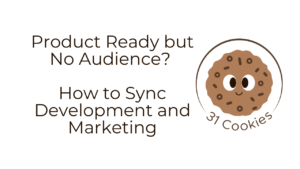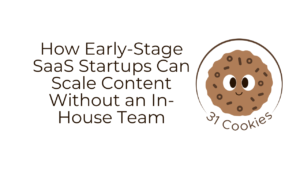You’re left wondering: is this content doing its job, or is it just taking up space?
This is where many B2B SaaS companies struggle: without the right metrics, it’s hard to gauge if your content is making an impact. But measuring the right data is crucial. It helps you pinpoint which content drives real value and informs your next steps.
In this blog, we’ll walk through the content marketing metrics that actually matter—so you can start measuring what counts. 🧮
🔍 Did You Know? 58% of B2B marketers reported increased sales and revenue in 2023 thanks to content marketing.
1. Website Traffic and Page Views
Why it matters
If your goal is to increase brand awareness and attract new visitors, monitoring this metric will help you determine whether your content is being seen by the right audience.
How to measure
Google Analytics offers an easy way to track website traffic and page views. Set up tracking for blog posts and landing pages to monitor the number of visitors, which pages they view, and how long they stay.
What to look for
Watch for traffic spikes after publishing new content, especially when you promote it through social media, email campaigns, or paid ads.
Steady traffic growth over time shows your content resonates, while sudden drops may indicate issues that need attention.
What comes next
Adjust your content strategy based on your traffic trends. If certain topics or formats generate more interest, consider producing more content in that area.
Conversely, if traffic is stagnating, it might be time to revise your SEO approach or explore new channels for content distribution.
2. Engagement Metrics
Why it matters
Engagement metrics—likes, shares, and comments—are crucial for understanding how well your content resonates with your audience. High engagement signals your content is compelling, encouraging readers to interact and share it with their networks.
How to measure
Social media platforms like Facebook, LinkedIn, and Twitter provide built-in insights to track engagement.
Additionally, blog comments can offer direct feedback from readers.
For deeper insights, consider tools like BuzzSumo, which tracks social sharing across various platforms, and Google Analytics, which monitors time on page and scroll depth.
What to look for
Monitor the number of likes, shares, and comments across your social media posts, how long visitors stay on your pages, and how far they scroll.
High levels of interaction indicate that your content is relevant and valuable, while a high time-on-page rate suggests that readers find the content engaging enough to stay longer.
What comes next
Refine your content strategy based on engagement insights.
If certain content formats (e.g., infographics or videos) or topics generate more interaction, consider producing more of that type. If engagement drops, experiment with new approaches, such as altering your call to action, adjusting tone, or targeting different audience segments.
🔍 Did You Know? Nearly 50% of buyers check out a company’s blog before deciding what to buy.
3. Conversion Rates
Why it matters
Conversions—such as sign-ups, downloads, or purchases—are the ultimate goal of content marketing.
While traffic and engagement show how well your content attracts attention, conversions demonstrate whether it effectively guides users down the sales funnel.
How to measure
Google Analytics is a powerful tool for tracking conversions. It allows you to set goals and monitor key actions such as form submissions, downloads, or demo requests.
Marketing automation platforms like HubSpot or Marketo can also track conversions and provide deeper insights into the customer journey.
What to look for
Focus on your call-to-action (CTA) performance, landing page conversions, and form submissions.
Users who interact with your CTAs but do not convert might signal friction in the user journey. Look for pages with high traffic but low conversions to identify content or UX issues.
What comes next
Optimize your content strategy by refining CTAs, landing pages, and forms. Adjust your content based on the conversion data to ensure you’re addressing the needs and pain points of your audience at every stage of their journey.
🧠 Fun Fact: Visitors spend more time on high-ranking websites, with top-ranking pages having lower bounce rates—an average of 60% for pages in the top ten.
4. Return on Investment (ROI)
Why it matters
ROI in content marketing is all about measuring how much revenue your content generates compared to the cost of producing it. Creating great content is one thing, but the real value lies in tying your marketing efforts directly to your bottom line.
How to measure
To calculate ROI, compare your content production costs (e.g., time, resources, tools) with the revenue generated from leads or sales attributed to that content.
Tools like HubSpot and Salesforce help track this by providing lead conversion and revenue attribution data.
What to look for
Compare your content ROI with customer acquisition costs (CAC) and customer lifetime value (CLV).
If the cost of acquiring a customer through content is lower than their lifetime value, your strategy is on the right track. Look for trends where content drives leads and fosters long-term customer relationships.
What comes next
Use your ROI data to make smarter content decisions. If certain content types or topics offer higher returns, allocate more resources there.
Continuously refine your approach to ensure content supports long-term profitability.
5. SEO Performance
Why it matters
SEO is essential for driving organic traffic and improving your content’s visibility in search engine results.
The higher your content ranks, the more likely it is to be discovered by potential customers.
For B2B SaaS companies, SEO performance directly influences how easily your audience can find your content. This leads to greater reach and more opportunities to convert visitors into leads.
How to measure
Key SEO metrics include keyword rankings, organic traffic, and backlink quality.
Tools like Google Search Console, Ahrefs, and SEMrush help track your keyword performance and monitor how your content ranks for targeted search terms.
Organic traffic tells you how much traffic comes from non-paid search results, while backlinks reflect content credibility and authority.
What to look for
Monitor improvements in keyword rankings, especially for high-value terms your target audience searches for. Keep an eye on organic traffic trends to understand if your content is attracting the right visitors.
Also, assess the quality of backlinks, as high-quality backlinks can significantly improve your content’s authority and search ranking.
What comes next
Focus on optimizing your content for SEO by improving keyword targeting, refining meta descriptions, and ensuring content is structured for search engines.
Regularly update content and earn quality backlinks to enhance rankings and drive more traffic.
🔍 Did You Know? Google processes over 40,000 searches per second! This shows how important SEO is for getting noticed online.
Serve Up Results With 31Cookies
Tracking the right content marketing metrics clearly shows how well your efforts are paying off.
With insights from key metrics like website traffic, engagement, and conversions, you can make smarter decisions to refine your strategy and boost results.
Do you think your content could perform better? ✅
We’ll help you track the metrics that matter and get the results you deserve. Chat with the 31Cookies team today—your free consultation is just a click away! 🍪








